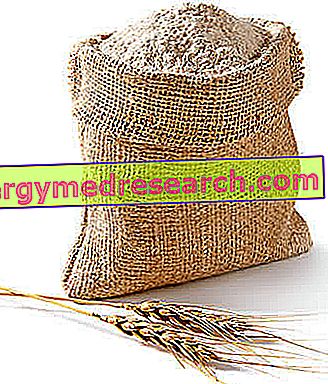Production
Flour and semolina production
After harvesting, wheat kernels are transported to mills, generally specialized for the production of flour (soft wheat) or semolina ( durum wheat).

Phases of flour and semolina production: summary
- The initial phase consists of cleaning the kernels from the impurities accumulated during the harvest; we would therefore have special systems equipped with sieves with more or less dense meshes, air jets that remove leaflets and spikes of ears, magnets to attract any bits of metal and a final wash to remove the dusty part.
- After cleaning, the kernels - now suitable for grinding - are sent to the next conditioning phase, in which a superficial humidification and low temperature stationing is generally carried out to facilitate breaking of the grain.
- Once this is done, the milling process takes place, in which the caryopsis is reduced to flour.
- Then the sifting or sifting takes place (buratto is synonymous with sieve).

At the end of the various stages we get:
- The flour - formed by small, roundish and white colored particles - in the case of working soft wheat;
- The semolina - formed from amber particles of greater dimensions, with sharp edge - in case you work hard wheat.
Scrap of flour and semolina
In both cases there is also a "waste" product called bran, which can be partially mixed with flour (to obtain an integral product) or used to feed livestock.
Note : We have recently begun to study a possible modification of this process, in order to allow the processing of the seeds still coated, equipped not only with the bran but also with the germ or embryo (an extremely noble part of the cereals).
Sifting of flour and semolina: what does it mean?
The sifting rate defines the purity of a flour and expresses the quantity of product (in kg) obtainable starting from a quintal of wheat; for example, a flour with a sifting rate of 95 is an integral type of flour, while a flour with a lower sifting rate is more refined (because the greater the waste).
Legislation
Classification and legal characteristics of soft and hard wheat flours
Classification of flour
| First name | Humidity max | Ashes min. | Ashes max | Protein min. (nitrogen x 5.70) |
| Type 00 soft wheat flour | 14.50% | - | 0.55% | 9, 00% |
| Soft wheat flour type 0 | 14.50% | - | 0.65% | 11.00% |
| Type 1 soft wheat flour | 14.50% | - | 0.80% | 12.00% |
| Type 2 soft wheat flour | 14.50% | - | 0.95% | 12.00% |
| Wholemeal wheat flour | 14.50% | 1.30% | 1.70% | 12.00% |
Table contained in Presidential Decree 9 February 2001, n. 187.
Values calculated on 100 parts of dry matter.
Note : the maximum humidity allowed on the market is 14.5% for all types of flour; in fact it was seen that when the humidity exceeds 16% the flour is not preserved; moreover, since a wet substance weighs more, higher values border on food fraud.
Classification of semolina
| Product name | Max. Humidity | Ashes min. | Max. Ash | Protein min. (nitrogen x 5.70) |
| Semolina * | 14.50% | - | 0.90% | 10.50% |
| granulated | 14.50% | 0.90% | 1.35% | 11.50% |
| Whole durum wheat semolina | 14.50% | 1.40% | 1.80% | 11.50% |
| whole wheat flour | 14.50% | 1.36% | 1.70% | 11.50% |
Table contained in Presidential Decree 9 February 2001, n. 187.
Values calculated on 100 parts of dry matter.
Moisture allowed up to 15.50% if indicated on the label. Proteins: Kjeldahl nitrogen * 5.7
Common frauds of flour and semolina
Together with olive oil and rice, flours are one of the most prone to frauds; the most common are:
- Increased humidity
- Cutting with flours of lower economic and nutritional value
- Semolina cuts with soft wheat flours (the latter has a lower commercial value than durum wheat, since the latter grows well only in hot and dry climates such as those typical of southern Italy); in particular, Italian law requires that industrial dry pasta be produced exclusively from semolina, tolerating a maximum degree of impurities of 4%.
Additives in flour and semolina
Flour and semolina can also be supplemented with certain food additives.
Some are legitimate, others are not.
Antioxidants for flour and semolina
Ascorbic acid (vitamin C): it is allowed as an antioxidant in soft wheat flours up to 200 mg / kg (it has a purely conservative purpose, as it preserves the flour from becoming rancid.
Lightening agents for flour
Whitening: used for a very short time many years ago, they still constitute the "scarecrow" of many contemporary eating styles. It must be clear that, in addition to not being admitted by law, these products were no longer found in food.
Differences
Flour VS semolina
Flour and semolina are similar but not the same products. In reality, as we have seen above, these are not two flours but two different categories.
This means that the discrepancies concern both a group compared to the other (flour VS semolina), and a specific product compared to the others of the same group (eg semolina VS semolina flour or 00 VS whole wheat flour).
Botanical species of flour and semolina
First of all, "flour" means the flour of the botanical species Triticum aestivum or soft wheat; on the contrary when we speak of "semola" or similar we refer to the Triticum durum or durum wheat.
In Italy, the former is cultivated mainly in the north, while the latter is cultivated in the south of the peninsula.
Uses of flour and semolina
They have different characteristics and generally, even if it is not a real rule, it is said that flour is the ideal ingredient for bread-making, while semolina is the best basis for the production of pasta. In reality, the only certainty is that in the south it is mainly used durum wheat while in the north the soft one is used.
Uses of flour
If it is true that flour is mainly used for bread-making, it is equally true that there can be substantial differences between one product and another.
First of all, in addition to the botanical species, variety also makes the difference. There are dozens of types, perhaps hundreds, selected for equally different reasons. With regard to uses, we could say that the characteristic mainly subject to variation is the so-called " force "; this could be defined as the relationship between the tenacity and elasticity of a dough obtained from flour and water. This parameter, indicated with the abbreviation W, subdivides 4 categories of flour, with a strength of between <90 and about 370. The greater the strength, the more important is the predisposition of the flour to leavening ; strong flours are recommended for bread-making and weak ones for dry pastry (eg biscuits).
By changing the felling, the chemical-physical characteristics of a product can be further modified. The less refined flours generally have less gluten and are less prone to leavening.
Uses of semolina
Instead, the semolina has more relevance for the production of pasta. This is because it resists cooking better. On the other hand, it is not excluded from some bread-making preparations typical of the south. Here, among the various types of semolina, it is necessary to prefer the " rimacinata " or in any case products with a lower grain size; unlike semolina and semolina, this is reduced to very small granules and more similar to those of soft wheat flour. This allows an effective formation of gluten in the dough needed for bread making; the same would not happen with larger granules, which would determine a hard and compact dough, little leavened.
It is no coincidence that thick semolina is used for the production of semolina, a first soupy dish to be consumed with a spoon. The same recipe made with thin semolina would give a too sticky result. This does not mean that each semolina can be used, even if in variable percentages and sometimes mixed with soft wheat flour, for any kind of recipe.
Other types
What are the other types of flour most used?
- Cereal flours : simple or composed, in addition to those of wheat, are widespread based on: rice, oats, maize (both flour from polenta and cornflour), barley, spelled, spelled, kamut, rye, millet, sorghum, etc.
- Pseudocereal flours : amaranth, quinoa, buckwheat, hemp, chia etc.
- Flour / tuber diets, tuberous roots and fruits: potato starch, cassava tapioca, casagne etc.
- Legume flour : the most famous are undoubtedly those of soy and peanuts, but recently they also find use of beans, chickpeas, peas, lupins, lentils, etc.
- Dextrinised flours : the starch is partially dextrinated for heating in order to make them more digestible.
- Malted flours : they are added with malt flour (germinated barley) or malt extract.
- Gluten-free flours : they are used in celiac diseases (gluten intolerance) and include many of those we have already mentioned: gluten-free cereals (rice, corn, oats *), legumes, pseudocereals, starch etc.
- Instant flours : by heating the starch granules are swollen and broken (= precooking); a typical example is that of instant polenta.
- Animal flours : obtained from ingredients of animal origin, intended for human consumption or other uses (animal feed, fertilization, etc.); flour with or of milk, fish meal, blood meal, bone meal and horns, etc.
* The toxicity of oats for celachis is still a matter of debate. In the past, in fact, it was excluded a priori from the celiac diet, while several studies depict it as relatively safe.
In particular, if introduced pure, that is not contaminated by wheat, barley or rye proteins during processing, oats would not be harmful for the most part (99.4%) of celiacs.
Today we know that the tolerability of oatmeal depends above all on the cultivar, or on the variety of oats used.
See also: Farinaceous
Recipes
- Recipes with re-milled durum wheat semolina
- Recipes with white type 00 flour
- Recipes with type 0 white flour
- Recipes with whole wheat flour
Bibliography
Can be taken in a gluten-free diet? A systematic review. Scand. J. Gastroenterol. Vol. 42, No. 2, pages 171-178.



